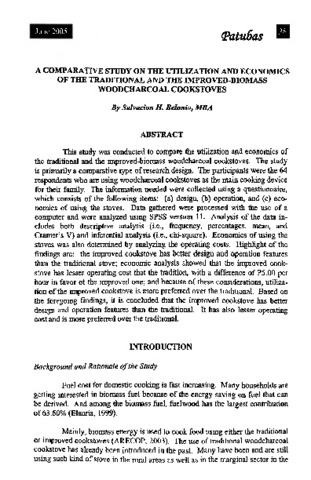Technical and performance evaluation of the local and the imported designs of clay-type woodfuel cookstoves
Abstract
The technical and performance evaluations of the local and the imported designs of woodfuel clay stoves were conducted at the Appropriate Technology Center, Department of Agricultural Engineering, College of Agriculture, Central Philippine University, Iloilo City from June 6 to 11, 2002. The main objective of the study was to compare the two stoves in terms of the technical merits and their performance as to time required to ignite fuel, time to boil water, amount of fuel consumed, thermal efficiency, and cost of boiling a liter of water.
The local stove was developed by the local producer in Western Visayas specifically in Dumarao, Capiz, where the unit was obtained. The imported stove, on the other hand, was obtained from Sri Lanka and is presently promoted by APPROTECH ASIA through a local Potter in Pavia, Iloilo. The locally designed unit was purchased from Pavia, Iloilo.
Technical evaluation of the stoves showed that the local stove is simpler in design as compared with the imported stove, which uses two burners instead of one. Wall thickness for the local stove is thicker by 0.3 cm than the imported. Both stoves have secondary air holes for proper combustion of volatile gases. The excess heat in the imported stove can be further utilized in the second burner which is considered as heat loss in the local stove.
Performance evaluation of the stoves showed that the wood fuel in the local stove attained spontaneous combustion within 2 to 4 minutes while in the imported stove spontaneous combustion was attained within 3 to 5 minutes. It was also found out that two liters of water can be boiled in the local stove from 29 to 100°C within 10 to 12 minutes while 4 liters of water can be boiled in the imported stove within 14 to 24 minutes. This implies that the imported stove is more efficient in boiling water than the local. The amount of wood fuel consumed per unit time ranged from 0.0192 to 0.0238 kg per minute for the local stove and 0.0223 to 0.0238 kg per minute for the imported.
The thermal efficiency is higher for the imported stove as compared with the local stove.
Operating cost analysis has shown that the cost of boiling water per liter - day is much lesser for the imported stove than for the local stove. Moreover, the cost of imported stove can be recovered within 30 days based on the savings of fuel derived from the use of local stove.
Paglalarawan
Abstract only
Mungkahing Sipi
Belonio, A. T. , Sotocinal, S. A. , Jr. & Lete, G. L. (2002). Technical and performance evaluation of the local and the imported designs of clay-type woodfuel cookstoves (Research report). Jaro Iloilo City: University Research Center, Central Philippine University.
Uri
Technical ReportMga Paksa
Mga keyword
Lokasyon ng Istante
GSL 630.72 B418t
Pisikal na paglalarawan
v, 25 leaves: color illustrations
Collections
- Research reports [167]
- Research reports [37]
Mga parehong item
Ipinapakita ang mga item na nauugnay sa pamagat, may-akda, tagalikha at paksa.
-
Design and performance evaluation of a batch-type rice hull gasifier stove
Belonio, Alexis T. (National Academy of Science and Technology, 1989)A batch-type rice hull gasifier stove was designed and its performance as a potential alternative fuel saving device for cooking was evaluated. The stove is a single-burner with a double-core, down draft type reactor. Gas ... -
A comparative study on the utilization and economics of the traditional and the improved biomass woodcharcoal cookstoves
Belonio, Salvacion H. (Central Philippine University, 2005-06)This study was conducted to compare the utilization and economics of the traditional and the improved-biomass wood charcoal cookstoves. The study is primarily a comparative type of research design. The participants were ... -
A comparative study on the utilization and economics of the traditional and the improved-biomass woodcharcoal cookstoves
Belonio, Salvacion H. (Central Philippine University, 2004-10)This study was conducted to compare the utilization and economics of the traditional and the improved-biomass woodcharcoal cookstoves. The study is primarily a comparative type of research design. The participants of which ...





